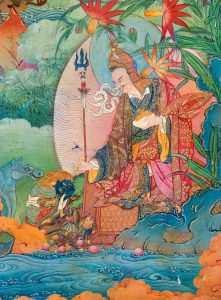Weather, Nagas, and Protectors (by Cameron Bailey)
In traditional Buddhist cultures there are a host of worldly gods and spirits that are believed to be able to control or influence the weather. In ancient, pre-Buddhist India, certain high gods, such as Indra, the king of the Vedic pantheon, were propitiated and worshipped in order win the favour of timely, life-giving rainfall (or alternatively, stopping excessive rain). Nagas, a pan-Indian class of subterranean snake spirit, were also generally assumed to be particular influencers of rainfall. Dwelling alternatively (or simultaneously) in chthonic aquifers and atmospheric storm clouds, nagas could cause drought or deluges at a whim. Early Indian Buddhism quickly integrated the cults of worldly spirits, including nagas, and Buddhist monks took on the role of interceding with these beings on behalf of the lay human community. Nagas were considered so especially important, largely due to their weather controlling abilities, that in later Mahayana and tantric Buddhism a number of scriptural and iconographic epiphanies focused especially on their worship, pacification, and control. Certain prayers to the Buddha Akshobhya are said to be particularly effective in pacifying nagas. There is even a buddha named Nageshvara Raja (“Lord King of the Nagas”) who is ritually invoked to create treasure vases that are buried in the earth to ensure timely rain.

Padmasambhava subjugating a naga king, Nele Thokar. Photo by Thomas Laird, at the Rubin Museum of Himalayan Art.
As Buddhism spread throughout Asia, so did its cults to worldly deities, including nagas. In east Asia nagas became dragons that slither through the air and herald the storms they cause with thunderous roars. In Tibet, nagas (or “lu,” in Tibetan) would join a vast pantheon of native and imported worldly spirits, many of which are believed to cause various weather events. In Tibet’s harsh climate, these spirits are seen as usually quite hostile, bringing down hail and frost which destroy crops and even outright kill animals and people who are caught unprepared. In response, Tibetan Buddhism developed numerous ritual techniques to bind and control these weather-making spirits, that even allowed a tantric sorcerer to use weather patterns as weapons of war. Milarepa, sometime known as the Great Sorcerer, famously used weather magic to destroy his enemies’ crops with hail.
The deity he invoked for this purpose was called the Maroon-faced Za, za being a generally malevolent class of planetary deities that rule earthly events, including environmental conditions such as storms. The Maroon-faced Za is one form of a deity called Rahula, who according to his mythic origins was born of a naga mother, and is an amalgam of several Indian deities, including the ancient Indian rain god Indra. In the Nyingma, or Old School of Tibetan Buddhism, Rahula is a significantly powerful dharma protector, and considered to be the supreme lord of the za. He is invoked for protection against damaging weather influences, as well as to cause them, when necessary.
Cameron Bailey is a PhD student in Tibetan studies at the University of Oxford.



